2019 MERCEDES-BENZ S CLASS check engine light
[x] Cancel search: check engine lightPage 170 of 578

iftheycome into contact withhot parts ofthe engine orexhaust system.
#Therefore,checkregularlythatthereare noflammable materials intheengine compartment or ontheexhaustsystem.
Requirements:RThe SmartKeyis located inthevehicle andthe SmartKeybattery is not discharged.
#Toswitch onthe power supply:press but‐ton1once.You can activatethe windshield wipers,forexample.
The power supplyis switched off again ifthefol‐lowing conditions are met:
Ryou openthe driver's door
Ryou press button1twice.
#Toswitch onthe ignition:press button1twice.The indicator lamps inthe instrument clusterlight up.
The ignition is switched off again if one ofthefollowing conditions is met:
Ryou do notstartthevehicle within15minutes.
The transmission is in position�].
or
The electric parking brake is applied.
Ryou press button1once.
Starting thevehicle
Starting thevehicle withthestart/stop but‐ton
Requirements:RThe SmartKeyis located inthevehicle andthe SmartKeybattery is not discharged.
#Shiftthe transmissiontoposition�]or�\\.
16 8Driving and parking
Page 398 of 578

Rfrequent operation in mountainousterrain oron poorroad surfaces
Rwhenthe engine is often leftidlingfor longperiods
Roperation in particularly dusty conditionsand/or if air-recirculation mode is frequentlyused
Inthese or similar operating conditions, havetheinterior airfilter, engine air cleaner, engine oiland oilfilteretc.changed more frequently. Thetires must bechecked more frequently ifthevehicle is operated under increased loads.Fur‐ther information can be obtained at aqualifiedspecialistworkshop.
Battery disconnection periods
The ASSYST PLUS service interval displaycan only calculatethe service due datewhenthe batteryis connected.
#Notedownthe service due date displayed onthe instrument display before disconnectingthe battery (→page 395).
Engine compartment
Active hood (pedestrian protection)
Operation ofthe active hood (pedestrian pro‐tection)In certain accident situations,therisk of injurytopedestrians can bereducedbythe actuationofthe active hood. Therear area ofthe hood israisedbyapproximately 80 mm.
Forthe drivetotheworkshop,resetthe trig‐gered active hoodyourself. Afterthe active hoodhas been triggered, pedestrian protection maybe limited.
Aqualified specialistworkshop mustre-instatethe full functionality ofthe active hood.
The active hood is notavailable in all countries.
Resettingthe active hood
&WARNINGRisk of burns from hot com‐ponent parts inthe engine compartment
Certain components inthe engine compart‐ment can beveryhot, e.g.the engine,theradiator and parts oftheexhaust system.
#Allowthe enginetocool down and onlytouch component parts described inthefollowing.
#Withyour handflat, push down active hood1inthe area aroundthe hinges on bothsides (arrows).The hood must engage in position.
#Ifthe active hood can beraised slightly attherear inthe area ofthe hinges,repeatthestep until it engages correctly.
396Maintenance and care
Page 424 of 578
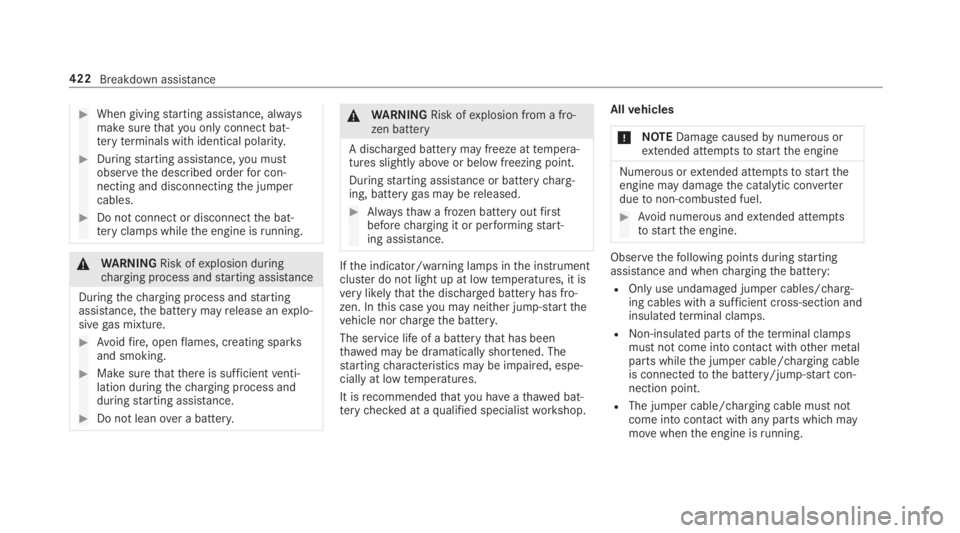
#When givingstarting assistance, alwaysmake surethatyou onlyconnect bat‐teryterminals with identical polarity.
#Duringstarting assistance,you mustobservethe described orderfor con‐necting and disconnectingthe jumpercables.
#Do not connect or disconnectthe bat‐teryclamps whilethe engine isrunning.
&WARNINGRisk ofexplosion duringcharging process andstarting assistance
Duringthecharging process andstartingassistance,the battery mayrelease anexplo‐sivegas mixture.
#Avoidfire, openflames, creating sparksand smoking.
#Make surethatthere is sufficientventi‐lation duringthecharging process andduringstarting assistance.
#Do not leanover a battery.
&WARNINGRisk ofexplosion from a fro‐zen battery
A discharged battery may freeze attempera‐tures slightly aboveor below freezing point.
Duringstarting assistance or batterycharg‐ing, batterygas may bereleased.
#Alwaysthawa frozen batteryoutfirstbeforecharging it or performingstart‐ing assistance.
Ifthe indicator/warning lamps inthe instrumentcluster do not light up at lowtemperatures, it isverylikelythatthe discharged battery has fro‐zen. Inthis caseyou may neither jump-startthevehicle norchargethe battery.
The service life of a batterythat has beenthawed may be dramatically shortened. Thestartingcharacteristics may be impaired, espe‐cially at lowtemperatures.
It isrecommendedthatyou haveathawed bat‐terychecked at aqualified specialistworkshop.
Allvehicles
*NOTEDamagecausedbynumerous orextended attemptstostartthe engine
Numerous orextended attemptstostarttheengine may damagethe catalytic converterduetonon-combusted fuel.
#Avoid numerous andextended attemptstostartthe engine.
Observethefollowing points duringstartingassistance and whenchargingthe battery:
ROnly use undamaged jumper cables/charg‐ing cables with a sufficient cross-section andinsulatedterminal clamps.
RNon-insulated parts oftheterminal clampsmust not come into contact withother metalparts whilethe jumper cable/charging cableis connectedtothe battery/jump-startcon‐nection point.
RThe jumper cable/charging cable must notcome into contact withany parts which maymovewhenthe engine isrunning.
422Breakdown assistance
Page 531 of 578
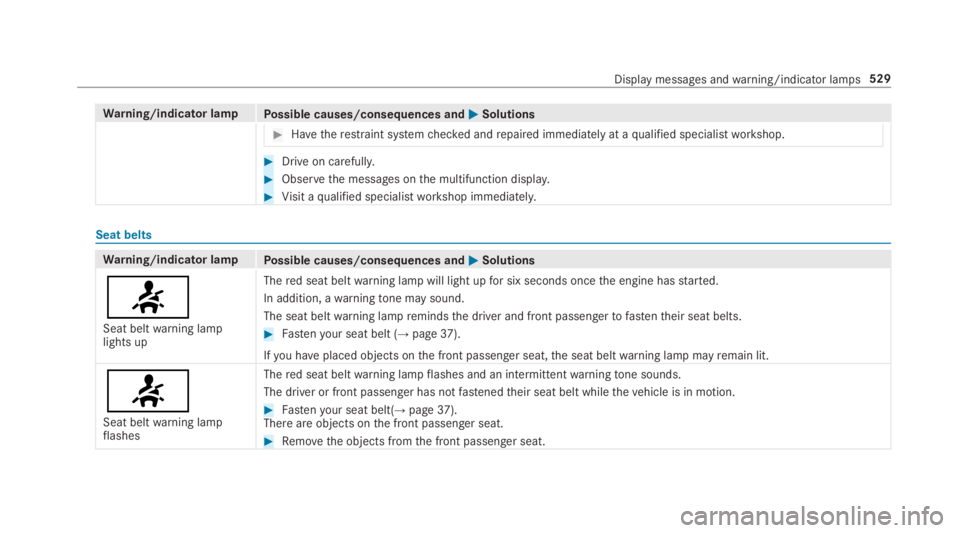
Warning/indicator lampPossible causes/consequences and�P�PSolutions
#Havetherestraint systemchecked andrepaired immediately at aqualified specialistworkshop.
#Drive on carefully.
#Observethe messages onthe multifunction display.
#Visit aqualified specialistworkshop immediately.
Seat belts
Warning/indicator lampPossible causes/consequences and�P�PSolutions
�v
Seat beltwarning lamplights up
Thered seat beltwarning lamp will light upfor six seconds oncethe engine hasstarted.
In addition, awarningtone may sound.
The seat beltwarning lampremindsthe driver and front passengertofastentheir seat belts.
#Fastenyour seat belt (→page37).
Ifyou haveplaced objects onthe front passenger seat,the seat beltwarning lamp mayremain lit.
�v
Seat beltwarning lampflashes
Thered seat beltwarning lampflashes and an intermittentwarningtone sounds.
The driver or front passenger has notfastenedtheir seat belt whilethevehicle is in motion.
#Fastenyour seat belt(→page37).There are objects onthe front passenger seat.
#Removethe objects fromthe front passenger seat.
Display messages andwarning/indicator lamps529
Page 533 of 578
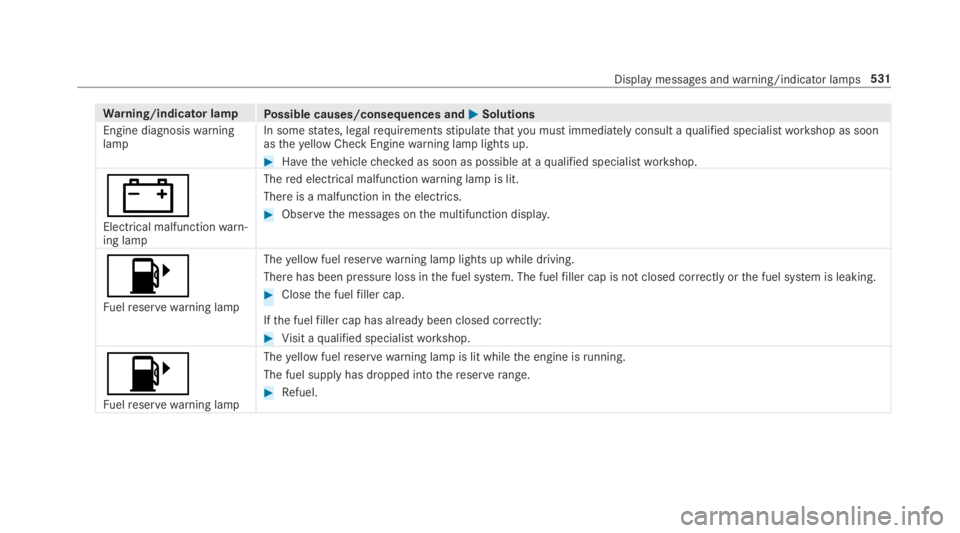
Warning/indicator lampPossible causes/consequences and�P�PSolutions
Engine diagnosiswarninglampIn somestates, legalrequirementsstipulatethatyou must immediately consult aqualified specialistworkshop as soonastheyellow Check Enginewarning lamp lights up.
#Havethevehiclechecked as soon as possible at aqualified specialistworkshop.
�=
Electrical malfunctionwarn‐ing lamp
Thered electrical malfunctionwarning lamp is lit.
There is a malfunction inthe electrics.
#Observethe messages onthe multifunction display.
�
Page 535 of 578
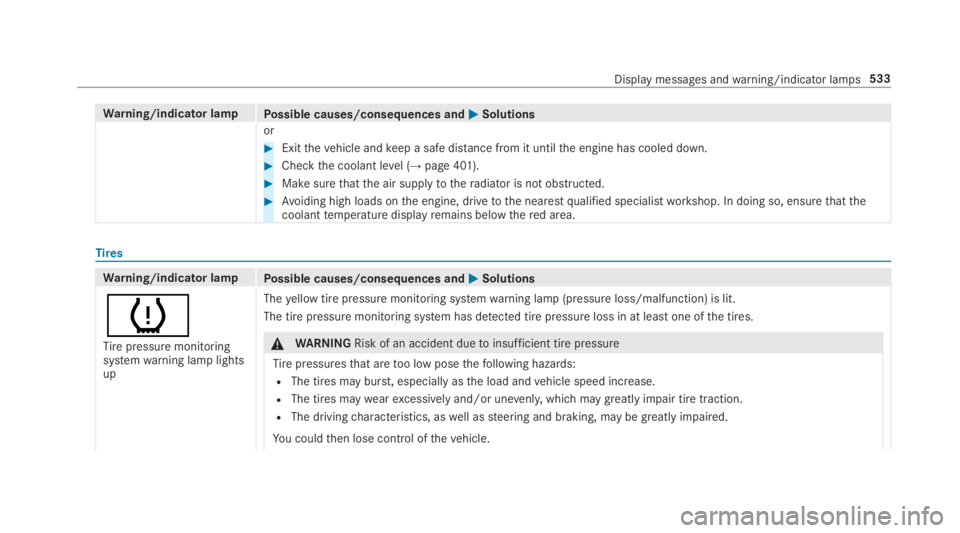
Warning/indicator lampPossible causes/consequences and�P�PSolutions
or
#Exitthevehicle andkeep a safe distance from it untilthe engine has cooled down.
#Checkthe coolant level (→page 401).
#Make surethatthe air supplytotheradiator is not obstructed.
#Avoiding high loads onthe engine, drivetothe nearestqualified specialistworkshop. In doing so, ensurethatthecoolanttemperature displayremains belowthered area.
Tires
Warning/indicator lampPossible causes/consequences and�P�PSolutions
�w
Tirepressure monitoringsystemwarning lamp lightsup
Theyellow tire pressure monitoring systemwarning lamp (pressure loss/malfunction) is lit.
The tire pressure monitoring system has detected tire pressure loss in at least one ofthe tires.
&WARNINGRisk of an accident duetoinsufficient tire pressure
Tirepressuresthat aretoo low posethefollowing hazards:
RThe tires may burst, especially asthe load andvehicle speed increase.
RThe tires maywearexcessively and/or unevenly,which may greatly impair tire traction.
RThe drivingcharacteristics, aswell assteering and braking, may be greatly impaired.
You couldthen lose control ofthevehicle.
Display messages andwarning/indicator lamps533
Page 546 of 578
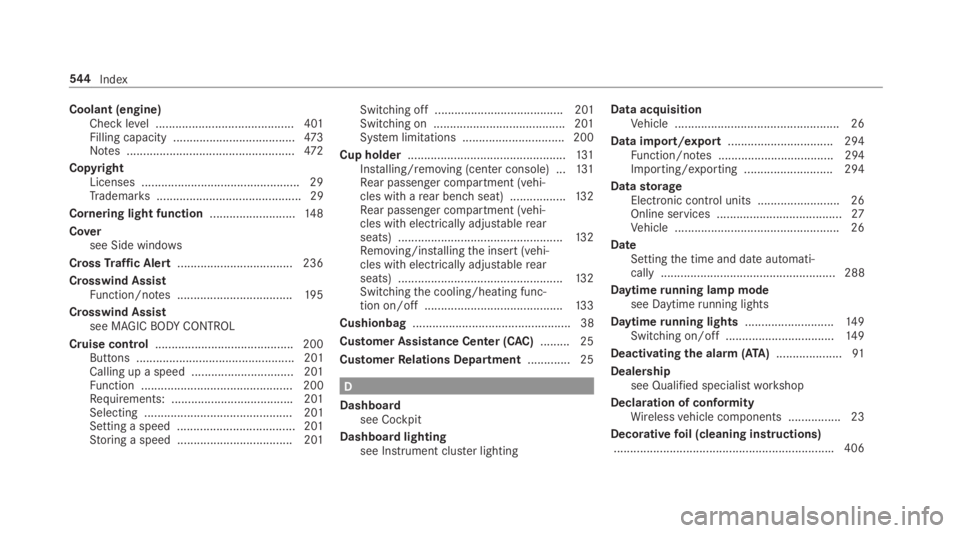
Coolant (engine)Check level .......................................... 401Filling capacity .....................................473Notes ...................................................472
CopyrightLicenses ................................................ 29Trademarks............................................ 29
Cornering light function..........................14 8
Coversee Side windows
CrossTraffic Alert...................................236
Crosswind AssistFunction/notes ...................................19 5
Crosswind Assistsee MAGICBODYCONTROL
Cruise control.......................................... 200Buttons ................................................ 201Calling up a speed ............................... 201Function .............................................. 200Requirements: .....................................201Selecting ............................................. 201Setting a speed .................................... 201Storing a speed ................................... 201
Switching off ....................................... 201Switching on ........................................201System limitations ...............................200
Cup holder................................................131Installing/removing (center console) ...131Rear passenger compartment (vehi‐cles with arear benchseat) .................13 2Rear passenger compartment (vehi‐cles with electrically adjustablerearseats) ..................................................13 2Removing/installingthe insert (vehi‐cles with electrically adjustablerearseats) ..................................................13 2Switchingthe cooling/heating func‐tion on/off ..........................................13 3
Cushionbag................................................ 38
Customer Assistance Center (CAC).........25
CustomerRelations Department.............25
D
Dashboardsee Cockpit
Dashboard lightingsee Instrument cluster lighting
Data acquisitionVehicle .................................................. 26
Data import/export................................ 294Function/notes ................................... 294Importing/exporting ........................... 294
DatastorageElectronic control units .........................26Online services ......................................27Vehicle .................................................. 26
DateSettingthe time and date automati‐cally ..................................................... 288
Daytimerunning lamp modesee Daytimerunning lights
Daytimerunning lights...........................14 9Switching on/off .................................14 9
Deactivatingthe alarm(ATA)....................91
Dealershipsee Qualified specialistworkshop
Declaration of conformityWirelessvehicle components ................23
Decorativefoil (cleaning instructions)...................................................................406
544Index
Page 553 of 578
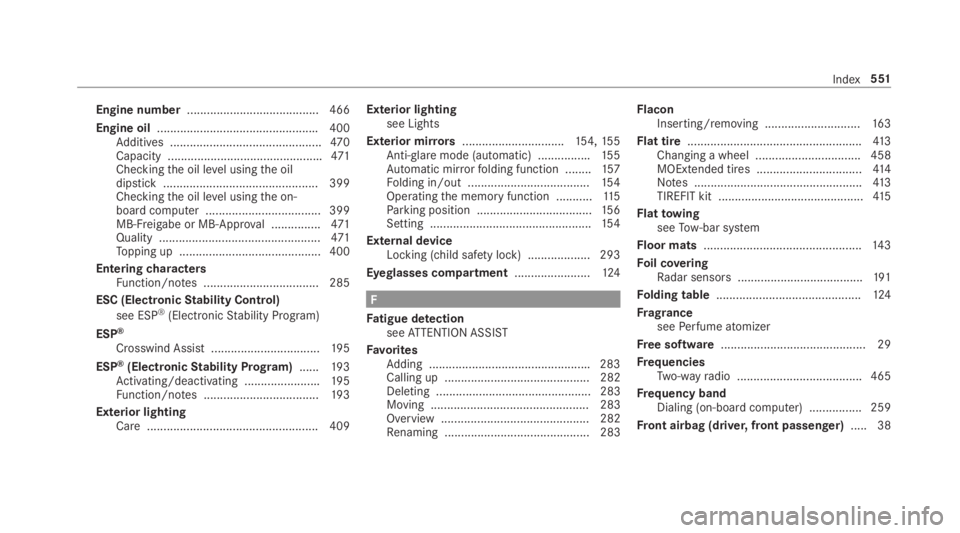
Engine number........................................ 466
Engine oil.................................................400Additives ..............................................470Capacity ...............................................471Checkingthe oil level usingthe oildipstick ............................................... 399Checkingthe oil level usingthe on-board computer ................................... 399MB-Freigabe or MB-Approval ...............471Quality .................................................471Topping up ...........................................400
EnteringcharactersFunction/notes ................................... 285
ESC (ElectronicStability Control)
see ESP®(ElectronicStability Program)
ESP®
Crosswind Assist .................................19 5
ESP®(ElectronicStability Program)......19 3Activating/deactivating .......................195Function/notes ...................................19 3
Exterior lightingCare .................................................... 409
Exterior lightingsee Lights
Exterior mirrors...............................154,15 5Anti-glaremode (automatic) ................155Automatic mirrorfolding function ........157Folding in/out .....................................154Operatingthe memory function ...........11 5Parking position ...................................156Setting .................................................154
External deviceLocking (child safety lock) ...................293
Eyeglasses compartment.......................124
F
Fatigue detectionseeATTENTION ASSIST
FavoritesAdding .................................................283Calling up ............................................ 282Deleting ............................................... 283Moving ................................................ 283Overview ............................................. 282Renaming ............................................ 283
FlaconInserting/removing .............................16 3
Flat tire.....................................................413Changing a wheel ................................ 458MOExtended tires ................................41 4Notes ...................................................413TIREFIT kit ............................................41 5
FlattowingseeTow-bar system
Floor mats................................................14 3
Foil coveringRadar sensors ......................................191
Folding table............................................124
FragranceseePerfume atomizer
Free software............................................ 29
FrequenciesTwo-wayradio ...................................... 465
Frequency bandDialing (on-board computer) ................ 259
Front airbag (driver, front passenger).....38
Index551